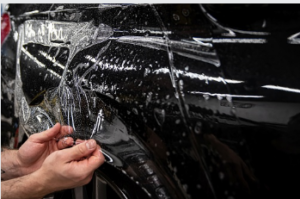Paint protection is one of the most important things you can do to keep your car looking great and increase its resale value. The decision on which type of protection is best for you will depend on your budget, car usage, and maintenance.
 Several options for protecting your vehicle’s paint include waxing, sealants, and ceramic coatings. Each CeramiCar paint protection Adelaide option has its pros and cons.
Several options for protecting your vehicle’s paint include waxing, sealants, and ceramic coatings. Each CeramiCar paint protection Adelaide option has its pros and cons.
Wax
Wax is a type of protection applied to a car’s surface to keep it in good condition. It helps preserve the paint’s clear coat and protect the vehicle from corrosive elements like rain, street salt, UV rays, bird droppings, and tree sap.
It can also help to fill minor scratches and imperfections. However, it will not prevent deeper scratches from forming on the paint or clear coat if it is not machine-polished first.
There are many different waxes, including natural and synthetic waxes (derived from plants and animals). While some waxes are more durable than others, they all do a great job of helping to protect your car’s paint.
Most waxes come in various forms, such as paste, spray, and liquid. In addition, some products combine sealants and resin to provide even more long-lasting protection for your vehicle’s paint.
The critical difference between a wax and a sealant is that a sealant is designed to last longer, offer better resistance to heat and detergent abuse, and provide more excellent durability than a comparable wax product. While waxes are still very effective, they don’t have the longevity of a sealant and often require frequent applications to maintain their effectiveness.
For this reason, it is recommended that you choose a wax product suitable for your personal preference and level of protection. For example, some people prefer the deep glossy shine a paint sealant provides, while others like wax’s durability and low maintenance.
Some premium wax products from Cartec, such as WaxCoat, Perfect Polish and Excellent PTFE Wax, offer an average of three to six months of protection. A top-of-the-line product is the Wax Guard, which consists of microfine particles that bond during treatment and create a protective layer on the car’s paintwork for one to a half to three years.
Wax is the most common product car enthusiasts and professionals use to help preserve and protect their vehicles’ paint. It does a great job of enhancing the colour of a painted finish, filling minor imperfections and producing a rich, deep look that other products cannot achieve.
Protective film
A paint protection film is a thin layer of urethane applied to your car’s exterior to protect its paint from scratches, rock chips and stains. It is a durable material that can withstand abrasion and oxidation from pollution, road debris and the sun.
There are various types of protective film, but the main goal is to protect the paint from scratches and damage so it can last longer. These films also cover other items like cell phones, TV screens, computers and more.
The first layer of a high-quality paint protection film comprises elastomeric polymers that return to their natural shape after being stretched or disfigured. It allows the film to heal itself when a small scratch is incurred.
This self-healing feature is essential in preserving your car’s paintwork. In addition, it eliminates the need to take your vehicle to a professional every time a slight scratch is created, saving you both money and time!
Ceramic coatings
A ceramic coating is a spray that aims to enhance the appearance of your car’s paint while also offering protection against damaging elements. It is often applied to the entire exterior of a vehicle, including the wheels and undercarriage. The spray comprises PTFE, silica and titanium dioxide, which protect your car’s paint.
The ceramic coating enables the paint to maintain its lustre for extended periods and helps prevent fading, corrosion and rust. It also blocks ultraviolet rays, which are harmful to the skin.
Another essential feature of a ceramic coating is that it makes cleaning easier and prevents dirt, salt and other harmful substances from sticking to your car’s surface. Its hydrophobic property achieves this, meaning water and other liquids can easily be wiped off the surface.
It is especially useful in harsh weather conditions like the Great Plains. In addition, the hydrophobic properties of a ceramic coating make it difficult for contaminants such as tree sap, bird droppings and dust to adhere to the surface.
In addition, it also makes it easier to remove stains and swirl marks from your car’s exterior. The hydrophobic effect of a ceramic coating allows moisture and other fluids to roll off the surface, reducing friction between your car’s body and dirt.
A professional-grade ceramic coating requires proper prep work and application to ensure that it will bond properly to your car’s paint and penetrate any imperfections or porous areas. The application process is similar to applying a stain to wood, and it needs to be done by an experienced professional.
While expensive, a quality ceramic coating will protect your car’s exterior. It will also keep your vehicle in good condition, reducing the need for frequent detailing and paint touch-ups. It can even help extend your vehicle’s life!
Paint correction
CeramiCar paint protection Adelaide is a specialised process that removes imperfections on the surface of your car’s clear coat. It can include scratches, swirl marks, spider webbing, and bonded contaminants.
These defects can make your vehicle look dull and hazed, so removing them as soon as possible is crucial. It is especially true for cars where things like water, salt, and sun exposure have been damaged.
A good paint correction process can improve your car’s appearance and restore its lustre and shine. It’s also a great way to increase the lifespan of your paint coatings and protect them from damage.